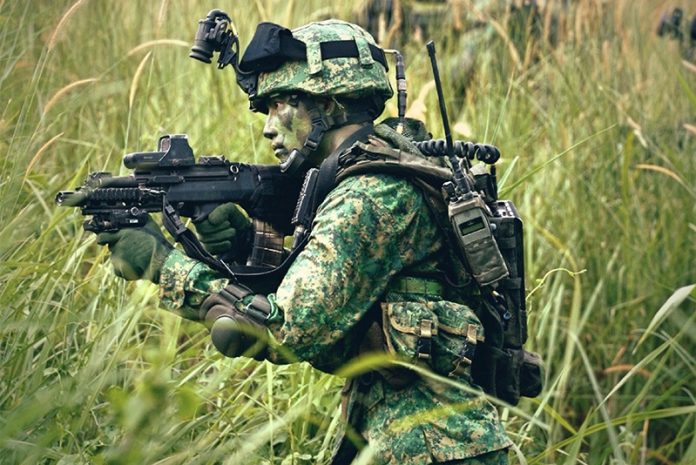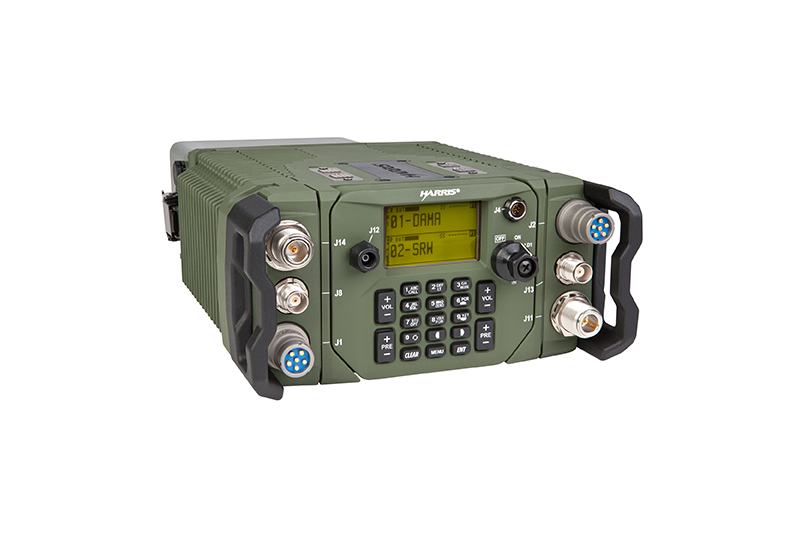
The challenge of upgrading to software defined radios will reduce the need to overcome issues with upgrading traditional hardware for Asian militaries.
Tactical radio technology is becoming increasingly capable and sophisticated, with industry pushing for more complex and integrated packages. But for Asian defence forces the most important features continue to be compatibility, weight, ease of operation, and cost.
Regional users also have disparate requirements, considering the wide range of operating environments from the thick foliage of Southeast Asian jungles to the vast mountain ranges of the Himalayas. Moreover, compatibility is taking on greater importance with military operations and training being conducted in coalitions. However, these efforts are hampered by legacy products that need to be included, as well as by several competing integration standards.
Radio-based communications can also be unreliable with environmental and technical challenges impacting on performances. Tactical networks for voice, data and video communications can be versatile and reliable, but a lack of international standards in communication architecture introduces several challenges, especially with ageing legacy systems that were not designed to connect to modern, data-enabled internet-protocol (IP) networks.
Regional forces are also beginning to adopt software-defined radios (SDRs), which not only enable additional capacities to be incorporated via software updates rather than replacing hardware, but also allow these forces to develop customised waveforms for enhanced security. Interoperability among radio sets is potentially increased because the same waveform software can be adopted to other SDR systems within the same standard.
Indonesia
The Indonesian Army (Tentara Nasional Indonesia-Angkatan Darat, or TNI-AD) soldiers are typically equipped with a tactical handheld or manpack radio during military operations.
Known radio sets in service include the venerable Associated Industries AN/PRC 77 manpack system, although this is being phased out for newer systems; the Alkom LRT-07H and LRT-08H (3 to 30MHz); and the General Dynamics URC-200 (V2) which is used by the Indonesian Air Force’s (TNI-AL’s) Paskhas special operations units for forward air control (FAC).
Meanwhile, the Indonesian Marine Corps (Korps Marinir) is understood to operate the Saab Systems Grintek (SSG) TR2400 which is part of the SSG tactical HF communication product range; which was developed to meet the requirements of the modern digital battlefield. The TR2400 HF SSB transceiver covers 1.6 to 29.9999MHz and is used primarily for long-range reconnaissance patrols by military and paramilitary forces. The transceiver provides the user with voice and data communications for manpack applications, as well as base station and vehicle installations. Micro/DSP technology is designed to provide configuration flexibility and a ready upgrade path. The TR2400 is also reported to have been supplied to the Bangladesh Armed Forces where it replaces the AN/PRC-77.
Indonesia is also pursuing indigenous SDR technology with defence prime PT Len producing the VDR10-MP SDR is a 10 Watt (20W PEP maximum) VHF manpack. The radio covers the 30-88MHz frequency range with a 16 kbit/s data rate. About 734 units are believed to have been ordered for the army, with deliveries commencing late 2015.
India
The Indian Army presently maintains the Army Radio Engineered Network (AREN), which is a secure HF system operated at the brigade level.
Indigenously developed FH radio sets with integral encryption devices have been introduced into service at the squad level and above in recent years. These include the LVP 275 VHF FH manpack radio, the LVP 285 and 333 VHF handheld radios (136-174MHz and 30-88MHz respectively), and LUP 291 secure ultra-high frequency (UHF) handheld radio, which are produced by Bharat Electronics Ltd (BEL).
BEL has also developed the Secured Tactical Army Radio System VHF (STARS-V) in 5 and 25 W power output configurations. The radios support communication in clear and secure voice and in data modes. The latest model, STARS-V Mk II was developed to provide secure tactical VHF radio communication in contested electronic environments.
According to BEL, STARS-V Mk II operates in the frequency band of 30.000 to 87.975MHz with 2,320 channels and 25kHz channel spacing. The radio can be configured as a manpack station with a suitable harness, a vehicular installation, or as a low power static station, with a number of these systems understood to have entered service with the Indian armed forces.
The country is also aiming to introduce next generation handheld and manpack SDRs to boost its network-centric warfighting capabilities. Stated requirements include a ground to ground communication range of over 3km for handheld systems, while manpack radios must have a range in excess of 10km. The Indian paramilitary forces already operate the MaxTech Savion SDR radio.
Singapore
The Singapore Armed Forces (SAF) largely operate the PRC-940A VHF manpack and the AHF-130 for HF communications, with some legacy PRC 640 VHF/HF dual-band radios still believed to be in service.
Communication devices are typically assigned to the squad level and above, with a specially trained signaller attached to a squad. More may be attached depending on the mission. However, specialised infantry units outfitted with the Advanced Combat Man System (ACMS) soldier suite are assigned individual Selex SSR+ systems.
The SAF unveiled that it has operationalized a software defined radio (SDR) capability with the vehicle borne and static Rockwell Collins-Thales FlexNet-One system, which is now an essential part of its Army Battlefield Internet system. Efforts to introduce compatible manpack SDR radios are believed to be under way.
Philippines
The Armed Forces of the Philippines (AFP) has traditionally relied on US systems for its tactical communications needs. Known tactical communication systems acquired prior to 2010 include Harris Corporation’s Falcon II RF-5800H-MP (export variant AN/PRC-150); Falcon II RF-5800V. Post 2010 acquisitions include the Falcon RF-7800V handheld VHF Combat Net Radio.

It is also a known operator of Israeli-made systems with Tadiran (now Elbit) supplying U$8 million worth of tactical radios to the AFP in 2002. However, the type of radios supplied has not been disclosed.
Harris Corporation announced in February 2016 that it had secured a $12 million order to provide the AFP with Harris Falcon III tactical vehicular radios, intercom systems and handheld radios. The company will provide the Light Armored Division of the Philippine Army with the Falcon RF-7800V Combat Net Radio integrated into the RF-7800I Intercom Systems, as well as the Falcon RF-7800V handheld VHF Combat Net Radio for general use by the army.
“These radios will provide soldiers in the Philippine Army with advanced command and control, and real-time situational awareness capabilities,” Brendan O’Connell, president, Tactical Communications, Harris Communication Systems, said in a statement. “They also will have secure interoperability with more than 15,000 Harris Falcon radios currently fielded within the AFP.”
In late 2017, funding was made available for an additional acquisition of 3,185 units 5W VHF handheld radios worth PHP678 million, and 150 units of 20W VHF manpack radios worth $4.35 million. Also funded was the Philippine Navy’s C4ISTAR project for an unspecified number of 5W VHF handheld radios worth $5.7 million. These as yet unspecified radios will be supplied by Harris Corporation under a Foreign Military Sales (FMS) programme with the US government.
Other Asian countries
The Royal Thai Army (RTA) operates the venerable AN/PRC25 and AN/PRC77 VHF/FM radios, as well as the Tadiran AN/PRC 624 VHF/FM and CNR-900 VHF (30-88MHz) station. The PRC-1099 manpack HF radio system is also used at the battalion level. Sources indicate radio sets are typically issued at the platoon level and above, but troops on security detail may also be provided with communication devices for situational awareness.
The Royal Cambodian Army (RCA) tactical communications systems and doctrine. The service is primarily a light infantry force that relies on foreign aid/supplied equipment. It is understood that much of the RCA’s present equipment is Chinese and Soviet-era vintage.
In 2016, China donated equipment for a trunked, two-way radio communications system along with over 1400 two-way radio handsets. The type remains unknown but sources suggest that these could be the PRC-7501 VHF frequency hopping (FH) hand-held radio, which operates in the 30 to 87.975MHz range and is interoperable with various manpack and vehicular VHF radios.
Japan produces its own radio equipment with no known exports currently observed. The country’s standard manpack is the JPRC-F70 manufactured by Mitsubishi, and are widely employed by the Japan Ground Self Defense Force (JGSDF).

Although much of indigenous development remain shrouded, US Federal solicitations allude to what appears to be a modern software defined radio (SDR) network, called the Broadband Multipurpose Wireless System, already in place as of 2015.
Japan’s NEC Corporation has also developed what it calls the ‘Field Communication System’ for the JGSDF. This comprises the Mobile Type I radio (handheld) and the Mobile Type II (manpack). These are stated to be capable of handling voice and data communications.The Mobile Type I handheld radio appear to be assigned to squad leader and above level.
South Korean firm LIG Nex1 produces the in-service PRC-999K VHF CNR, as well as the smaller but incompatible PRC-96K, for the Republic of Korea Army. The PTRC-999K is a VHF/FM combat net radio (CNR) designed for voice and data applications. According to the company, the low power, broadband equipment offers more channels than conventional VHF/FM CNRs. LIG Nex1 has also developed the PRC-999KE, a smaller and lighter version of the original radio with improved VHF performance, extended battery life, and embedded GPS.
The country is also benefiting from SDR technology through LIG Nex1’s Tactical Multi-Mode Radio (TMMR) effort as part of the wider Tactical Information Communications Network (TICN) transformation programme. TICN brings together expertise from LIG Nex1, Huneed Technology, and SamsungThalesJV (now Hanwha Systems) to develop the future tactical communications infrastructure for the army and marines, and is expected to replace large quantities of legacy CNR sets the TMMR through 2020.
The Sri Lanka Army (SLA) expanded rapidly in the 1983 to 2009 period during the civil war against the Liberation Tigers of Tamil Eelam (LTTE) rebellion in the north of the country, prompting the government to update some of the SLA’s equipment in order to deal with the threat.
The country is known to operate Turkish ASELSAN PRC-9600 VHF radio. Meanwhile, Special Infantry Operations Teams (SIOT), which have been at the forefront of past combat operations with the LTTE are understood to be equipped with indigenously developed HF radio sets with extended antennas that boost useable range to 54km, up from the 45km potential of unmodified systems.
by JR Ng










